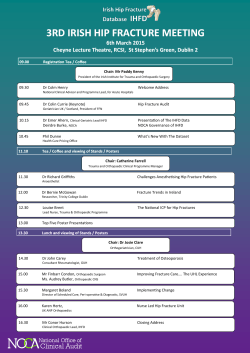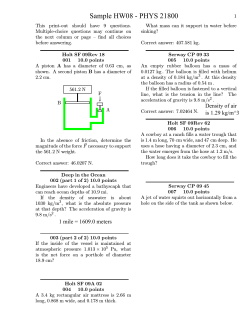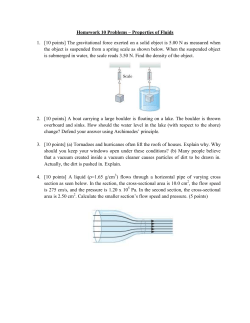
Energy Pipelines CRC â Innovation Roadmap â Fracture Control
Energy Pipelines CRC – Innovation Roadmap – Fracture Control Match research outcomes with future requirements Research Activities Modelling of Decompression wave velocities Increase understanding of requirements RP3-02A: decompression processes for CH4, CO2, and other gasses understood Develop a solution Implement solution RP3-02E: effects of pipe wall roughness and pipe diameter on decompression wave speed understood RP7.2.1 / 7.2.2 / 7.2.3: behaviour of CO2 mixtures understood by comparing EOS and field testing Coupled Fracture / Decompression Models Increase understanding of gas decompression for pipe design RP3-08: model for transient depressurization of a densephase fluid, incl. single/multiphase flow and heat transfer RP3-02I: fracture control model (EPDECOM) developed RP3-02F: improved fracture / decompression models developed RP3-02C/RP3-02J: 3D FEM simulation models for CVN tests, DWTT and full scale pipe fracture developed/ improved Fracture Simulation RP6.1-03: relationship found between absorbed CVN energy and wall thickness in clean/ dirty linepipe steel New fracture velocity model developed Improve prediction methods for material requirements and for fracture arrest Inform AS2885 update process RP6.1-04: solution to facilitate DWTT for smaller diameter pipes developed Knowledge / IP developed *Understanding of decompression behaviour of CH4, CO2 (mixtures) and other rich gasses *Understanding of effects of pipe wall roughness and diameter on decompression wave speed *Understanding of relationship between absorbed CVN energy and wall thickness in linepipe steel *Development of a model for transient depressurization of a dense-phase fluid *Development of 3D FEM simulation models for CVN tests, DWTT and full scale pipe fracture *Development of FSI model for dynamic ductile fracture in gas pipelines *Development of improved coupled fracture / decompression models *Development of solution to facilitate DWTT for smaller diameter pipes © Energy Pipelines CRC 2015 Developing improved fracturedecompression models Improve understanding of fracture propagation processes RP6.3-06: new FSI model for dynamic ductile fracture in gas pipelines developed RP3-09: Instrumented charpy machine installed Needs / Requirements Utilisation IP *Release of EPDECOM Fracture control software *Inform AS2885 update process *Release of research reports and models *Education and training of industry Identify and utilise/commercialise IP Methods for fracture control in small diameter natural gas and other energy fluid pipelines is a main theme in RP3. The scoping study in this area of research, RP3-02A ‘Modelling of Decompression Wave Velocities’ was designed to ensure that the program of Computational Fluid Dynamic (CFD) modelling and related research work be as effective as possible. The first research efforts into decompression velocities in gas pipelines were completed with project RP3-02E ‘Decompression Velocities in Rich Gas Mixtures’. This project involved numerical analysis of decompression processes following pipe ruptures and other transient events. A decompression wave speed model, EPDECOM, which exhibits higher accuracy than the currently available models such as GASDECOM, is able to predict the effects of pipe diameter and pipe wall roughness on the decompression wave speed. An improved research version of EPDECOM has been completed (RP3-02I ‘Fracture Control Software’) in which the direct interaction of gas decompression and fracture propagation at the crack tip is considered (project RP3-02F ‘Coupled Model for Fracture Propagation’). This version of EPDECOM also builds on the fracture simulation work conducted in projects RP3-02C/RP3-02J and data obtained from full scale fracture test carried out elsewhere in the world. Project RP3-06 aims to develop accurate numerical models of Fluid-Structure Interaction (FSI) during running ductile fracture as an alternative to full-scale testing. To ensure the absence of brittle propagation in smaller diameter pipelines, it has been proposed that the DWTT diameter limit in API/ISO standards be extended to DN300. However, there are issues with obtaining valid DWTT results from high Charpy toughness pipe for small pipe diameters and these are being addressed in RP6.1-04 ‘Pipe Size Effect in DWTT’ and RP6.1-03 ‘Toughness Review’. The determination of the material toughness value required for arresting ductile fracture propagation has been historically based on the Battelle Two-Curve Model (BTCM). However, the current emulations of the BTCM are ambiguous and the approach taken by AS2885.1 to specification of fracture control will be reviewed in the project RP6.1-03 ‘AS2885.1 Toughness Review’ (RP1/RP3 project). © Energy Pipelines CRC 2015
© Copyright 2025









